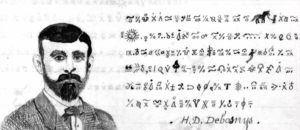For the last couple of weeks, I’ve been trying to work out if there was a way I could set up a funding page for a genealogist-driven collaborative effort to identify Henry Debosnys from his DNA.
Obviously, the funding would need to cover the two physical stages:
- Extracting his DNA – the nice people at the Adirondack History Museum have both his skull and the hangman’s noose that killed him (the skin on his neck was abraded for four inches, according to a contemporary newspaper report), so this looks to be achievable; and
- Scanning the extracted DNA and uploading it into some historical database for familial matches (the same as virtually every other programme on TV at the moment).
It turns out that extracting his DNA is the (relatively) easy part. The second part is actually much trickier, because it seems that pretty much all the consumer services out there (e.g. AncestryDNA, even Nebula Genomics) have highly optimised their low-cost DNA acquisition pipelines for either cheek-swab / saliva samples or blood samples.
Moreover, the helpful support people at AncestryDNA also told me that it would explicitly go against the company’s policy to take DNA samples from someone who had died. So there would seem to be a series of mountains for historical researchers to climb there.
Note that there are a (very small number of) commercial whole genome scanning services out there that don’t rely on cheek swabs or blood: but my understanding is that these tend to be quite expensive. So as of right now, it would seem that we’re kind of stuck between the two: crowdfunding a cheek swab test would be do-able (probably south of 1000USD, all in), but I’m guessing that this would rise to about 2500USD with a bespoke special WGS from extracted DNA.
Having recently spent time going through French archives via filae.com, I had thought that trying to track Debosnys’ genetic footprints would be a great project to crowdfund and take on, but I’ve been left somewhat bemused. So if anyone reading can suggest a better route forward for scanning extracted DNA and then GEDmatching it, please leave a comment below, I’m all ears!
Finally, I should mention an alternative route. Australian DNA genealogy company totheletter DNA have been offering a (really rather incredible) service where you send them old letters / stamps and they then extract DNA from the saliva used to stick the dried adhesive down. However, it turns out that they’ve been having some problems with the quality of the DNA extracted in this way, so they temporarily halted the service last year, but hope to bring it back online later this year (2021).

I think that the contamination on that rope would most likely render it impossible to analyze. Perhaps the skull? If we know where he is buried, exhumation would be the best bet. But who is going to approve and do that? Same shit, different show.
Hoops. Forgot. He wasn’t buried. Sold his body. So, dna with just the skull is all we have.
Contact Cece Moore at https://thednadetectives.com/
Peter Davidson: great tip, thanks!
Did you get in touch with Cece?
misca: I have just emailed Cece, so I guess we’ll see where this leads…
Nick – That’s great! She does excellent work! Could be interesting.
This is absolutely fascinating. I’m an Elizabethtown native and I’ve also worked at the Adirondack History Museum where the skull “resides.” There is nothing like spending a dark Halloween night with “Henry” as your only company in the very spooky old building.
I highly doubt there is anyway to obtain viable DNA from the cranium. The skull was shellacked at some point, and was also an anatomical model at the local school. It went from the doctor to the school to the museum (with the rest of the body getting “lost” along the way… I’ve heard rumors that someone knows what happened, but I doubt you’ll get anywhere since the family of Betsy Wells is still in the area. Adirondackers have long memories.
The noose has been handled by everyone and their kin over the past 140 years and is highly contaminated. There’s no way to isolate specific DNA.
There is a very minute chance that DNA could be extradited from a tooth, but I doubt it is feasible.
The records of Essex County still aren’t all online, and I have doubts if that will happen anytime soon. The area is exceptionally rural, there are few people, and trying to process everything to make it accessible would take significant funding that isn’t there.
I would love to see the code cracked, and if there’s something local “boots on the ground” can do to help you puzzle this out, please feel free to reach out.